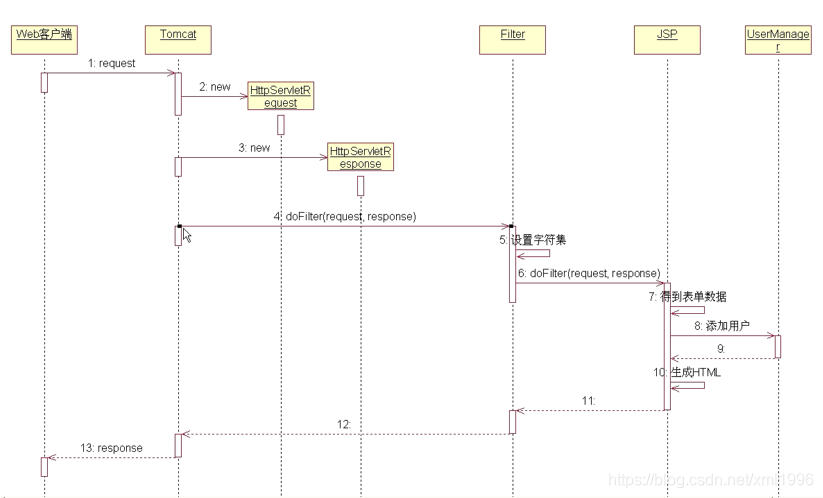目录
2、自定义拦截器类,继承servlet包下的Filter接口
一、过滤器Filter:
类似于AOP面向切面编程;提供了一种声明式的服务,有可插拔能力;Filter对Request,Response请求进行了拦截,在初始化的时候被实例化一次,之后不会再被实例化
1、实例:
比如:所有请求的页面设置统一的字符集:

2、自定义拦截器类,继承servlet包下的Filter接口
当有请求是url带有.jsp结尾,调用filter-name=CharseEncodingFilter的拦截器类
web.xml下配置拦截信息
1、filter拦截器是谁fiter-name; 路径是啥 filter-mapping
2、fiter-mapping中的url-pattern要对谁拦截
<filter>
<filter-name>CharseEncodingFilter</filter-name>
<filter-class>filter.CharseEncodingFilter</filter-class>
</filter>
<filter-mapping>
<filter-name>CharseEncodingFilter</filter-name>
<url-pattern>*.jsp</url-pattern>
</filter-mapping>
import javax.servlet.*;
import java.io.IOException;
/**
* Created by 邢美玲 on 2020/3/10 18:27.
* 字符集类型设置的拦截方法
* @Version 1.0
*/
public class CharseEncodingFilter implements Filter {
@Override
public void init(FilterConfig filterConfig) throws ServletException {
}
@Override
public void doFilter(ServletRequest servletRequest, ServletResponse servletResponse, FilterChain filterChain) throws IOException, ServletException {
// 设置字符集类型
servletRequest.setCharacterEncoding("UTF-8");
// 继续执行后面的内容
filterChain.doFilter(servletRequest,servletResponse);
}
@Override
public void destroy() {
}
}
二、拦截器:Interceptor:
拦截器(Interceptor):是Struts2框架的核心功能之一,Struts 2是一个基于MVC设计模式的开源框架, [3] 主要完成请求参数的解析、将页面表单参数赋给值栈中相应属性、执行功能检验、程序异常调试等工作。
Struts2拦截器是一种可插拔策略,实现了面向切面的组件开发,当需要扩展功能时,只需要提供对应拦截器,并将它配置在Struts2容器中即可,如果不需要该功能时,也只需要在配置文件取消该拦截器的设置,整个过程不需要用户添加额外的代码。
拦截器中更为重要的概念即拦截器栈(Interceptor Stack),拦截器栈就是Struts2中的拦截器按一定的顺序组成的一个线性链,页面发出请求,访问Action对象或方法时,栈中被设置好的拦截器就会根据堆栈的原理顺序的被调用。
实例:
自定义拦截器:截获用户请求, 判断用户是否已经登录
拦截类继承MethodFilterInterceptor 或者 AbstractInterceptor(MethodFilterInterceptor 是 AbstractInterceptor的子类 )
Struts下的xml文件中配置
在用于请求该addminFirst_findAll.action的时候调用name=PrivilegeInterceptor的拦截类,起到在执行方法之前先判断权限的目的
<!--后端管理端的权限拦截器-->
<interceptors>
<interceptor name="PrivilegeInterceptor" class="interceptor.PrivilegeInterceptor"/>
</interceptors>
。。。。。。
<!--管理端一级分类管理Action-->
<action name="adminFirst_*" class="adminCategoryAction" method="findAll">
<result name="findAllSuccess">/admin/category/list.jsp</result>
<interceptor-ref name="PrivilegeInterceptor"/>
<interceptor-ref name="defaultStack"/>
</action>
从ServletActionContext的Session中获取到值
public class PrivilegeInterceptor extends MethodFilterInterceptor{
@Override
protected String doIntercept(ActionInvocation actionInvocation) throws Exception {
// 判断是否登录,如果登录,放行,没有登录,跳转到登录页面.
AdminuserEntity adminUser = (AdminuserEntity) ServletActionContext.getRequest()
.getSession().getAttribute("existAdminUser");
if(adminUser != null){
// 已经登录过,继续向下调用
return actionInvocation.invoke();
}else{
// 跳转到登录页面:
ActionSupport support = (ActionSupport) actionInvocation.getAction();
support.addActionError("您还没有登录!没有权限访问!");
return "loginFail";
}
}
}
三、监听器listener:
在Servlet规范中定义了多种类型的监听器,它们用于监听的事件源分别为 ServletContext, HttpSession 和 ServletRequest 这三个域对象。

实例:
需求描述:登录的时候 每登录一次就需要加载一次权限信息,所以在用户第一次启动运行项目的时候,把所有权限的功能都加载存放在Application中
自定义监听器 继承servlet-api下的ServletContextListener
public class InitListener implements ServletContextListener {
/*初始化的时候*/
@Override
public void contextInitialized(ServletContextEvent sce) {
System.out.println("加载------contextInitialized");
// 获取容器与相关的Service对象
ApplicationContext ac = WebApplicationContextUtils.getWebApplicationContext(sce.getServletContext());
PrivilegeService privilegeService = (PrivilegeService) ac.getBean("privilegeServiceImpl");
// 把所有权限都加载存入Application
List<Privilege> privilege = privilegeService.findAll();
sce.getServletContext().setAttribute("privilegeList",privilege);
}
}【对代码中的如下部分说明】
ApplicationContext ac = WebApplicationContextUtils.getWebApplicationContext(sce.getServletContext());
PrivilegeService privilegeService = (PrivilegeService) ac.getBean("privilegeServiceImpl");
个人理解:在项目初始化加载的时候调用这个监听器类,这个类是通过配置文件web.xml读取,通过反射机制的实现的实例化,
这里的例子是集成了spring,所以想要获取Service层的业务类,需要获取到spring的容器,从容器中获取到你需要的对象。
spring提供了一个这样的接口WebApplicationContextUtils,可以获取到你需要的对象进行调用
前端JSP页获取方式:#application.privilegeList
<%-- 显示一级菜单 --%>
<s:iterator value="#application.privilegeList">
<li class="level1">
<div onClick="menuClick(this);" class="level1Style">
<img src="style/images/MenuIcon/${id}.gif" class="Icon" />
${name}
</div>
</li>
</s:iterator>






















 3235
3235











 被折叠的 条评论
为什么被折叠?
被折叠的 条评论
为什么被折叠?










